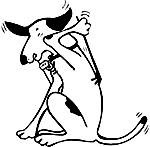|
Schnauzer Skin ConditionsSchnauzer skin conditions are not uncommon within the breed. While the majority of Schnauzers will have no problems at all, some do suffer from sensitive skin or allergies, often causing them to scratch, bite or lick themselves excessively.
Canine skin disorders are a complex topic. Some dogs can spend hours running through fields, digging holes and rolling around in the grass with no after effects at all. Others may spend most of their time indoors and have an excellent diet, but still experience severe itching. Skin problems may be the result of one or more of a wide range of causes - and the list of potential remedies and treatments is even longer! It's by no means possible to cover all of them in this article. What we hope to do is give you a broad outline of the main categories and causes of Schnauzer skin conditions. We recommend you seek advice from your vet or a canine nutrition expert if your Schnauzer has a problem. Most Schnauzer skin conditions need to be diagnosed by your vet. Before he or she can do that, you'll have to tell him or her all about your dog's diet, exercise regime and habits, medical history and local environment. The vet will then carry out a thorough physical examination, possibly followed by further tests, before he or she can prescribe the correct treatment.
Canine dermatitis means inflammation of the dog's skin and it can be triggered by a great number of things. These causes can be divided into several categories. They are:
Environmental or Contact Irritations.
These Schnauzer skin conditions are a direct reaction to something the dog physically comes into contact with. It could be as simple as grass, specific plants or other animals.
Other possible triggers include dry carpet shampoos, caustic irritants, new carpets or cement dust. The irritation may be restricted to the part of the dog - such as the underneath of the paws or belly - which has touched the offending object
Symptoms are skin irritation - either a general problem or specific hotspots - itching (your vet may call this "pruritis") and sometimes hair loss. Diet and Food Allergies
Without proper food a dog’s whole body - not just his skin and coat - will continuously be under stress. Cheap dog foods bulked up with grains and other ingredients can cause problems. If you do feed your dog a dry commercial dog food (like we do) then make sure that the first ingredient listed on the sack is meat or poultry. Having said that, there is considerable anecdotal evidence that dogs with nutritional skin problems can do well on a purely vegetarian diet. Another option is to put your Schnauzer on a high protein pure meat diet. Both of these options are expensive and time consuming for the owner, but can have impressive results in some cases. You can find out more on this by reading our article on Dog Food Allergies.
Parasites
You can often see the fleas if you part your dog's fur. With Schnauzer skin conditions, parasites would be the first things to eliminate. There are plenty of commercial solutions such as Frontline and Advantix for fleas, ticks and other parasites. (Flea bites are different from flea bite allergies). Other parasites include mange, ear mites, lice and ticks. If your Schnauzer has particularly sensitive skin, you might want to try a natural flea or tick remedy. Allergies Allergies are one of the most common causes of Schnauzer skin conditions. This is a BIG subject, whole books have been written on the topic.. Here are some of the main points in a nutshell:
Inhalant Allergies.
A clue to diagnosing these allergies is to look at the timing of the reaction. Does it happen all year round? If so, this may be mold or dust. If the reaction is seasonal, then pollens may well be the culprit. Symptoms of inhalant allergies include scratching, biting, chewing at paws and constant licking. The itching may be most severe on feet, flanks, groin and armpits. Dogs may also rub their face on the carpet. Flea Bite Allergies
Just one fleabite in a sensitised Schnauzer will cause intense and long-lasting itching. Most of the damage is done by the dog scratching, rather than the flea bite. This can result in the dog's hair dropping out or skin abrasions. Some dogs will develop round, red, painful sores called hot spots. These can occur anywhere, but are often along the back and base of the tail. Flea bite allergy is the most common form of canine skin allergy and can only be totally prevented by removing all fleas from the dog's environment. Other Causes some other reasons for Schnauzer skin conditions are:
Bacterial infection (Pyodermas). Early signs are itchy yellow spots filled with pus, and possibly later red ulcerated skin with dry, crusty patches. Often dog bacterial problems are signs of another skin condition, such as parasites, allergies or a hormonal imbalance. Following a consultation with your vet, a course of treatment will follow, which may include antibiotic capsules or ointments.
Ringworm. The fungi live in dead skin, hairs and nails and the head and legs are the most common areas affected. Tell-tale signs are bald patches with a roughly circular shape. Ringworm is usually treated with fungicidal shampoos or antibiotics.
Hormonal Imbalances. One visual sign is often hair loss on both sides of the dog's body. The condition is not usually itchy. Hormone imbalances can be serious as they are often indicators that glands which affect the dog internally are not working properly. However, some types can be diagnosed by special blood tests and treated effectively. We have only just touched on the complex subject of skin disorders in dogs. As you can see, the causes and treatments are many and varied. In order for your dog to remain as healthy as possible, we strongly recommend you get a professional diagnosis from your veterinarian before attempting to treat the condition.
Return from Schnauzer Skin Conditions to the Home Page
|
AVAILABLE ON AMAZON AS PRINTED BOOK AND KINDLE! The definitive manual for owners of Miniature Schnauzers, Giants and Standard Schnauzers

"The Schnauzer Handbook is brilliant and covers almost all you want to know about the breed," Michele L, Bournemouth
"A thoroughly interesting and entertaining book. There’s hardly anything about schnauzers that isn’t in here - it even made me smile!" J. Garrard, Ormond Beach, Florida





